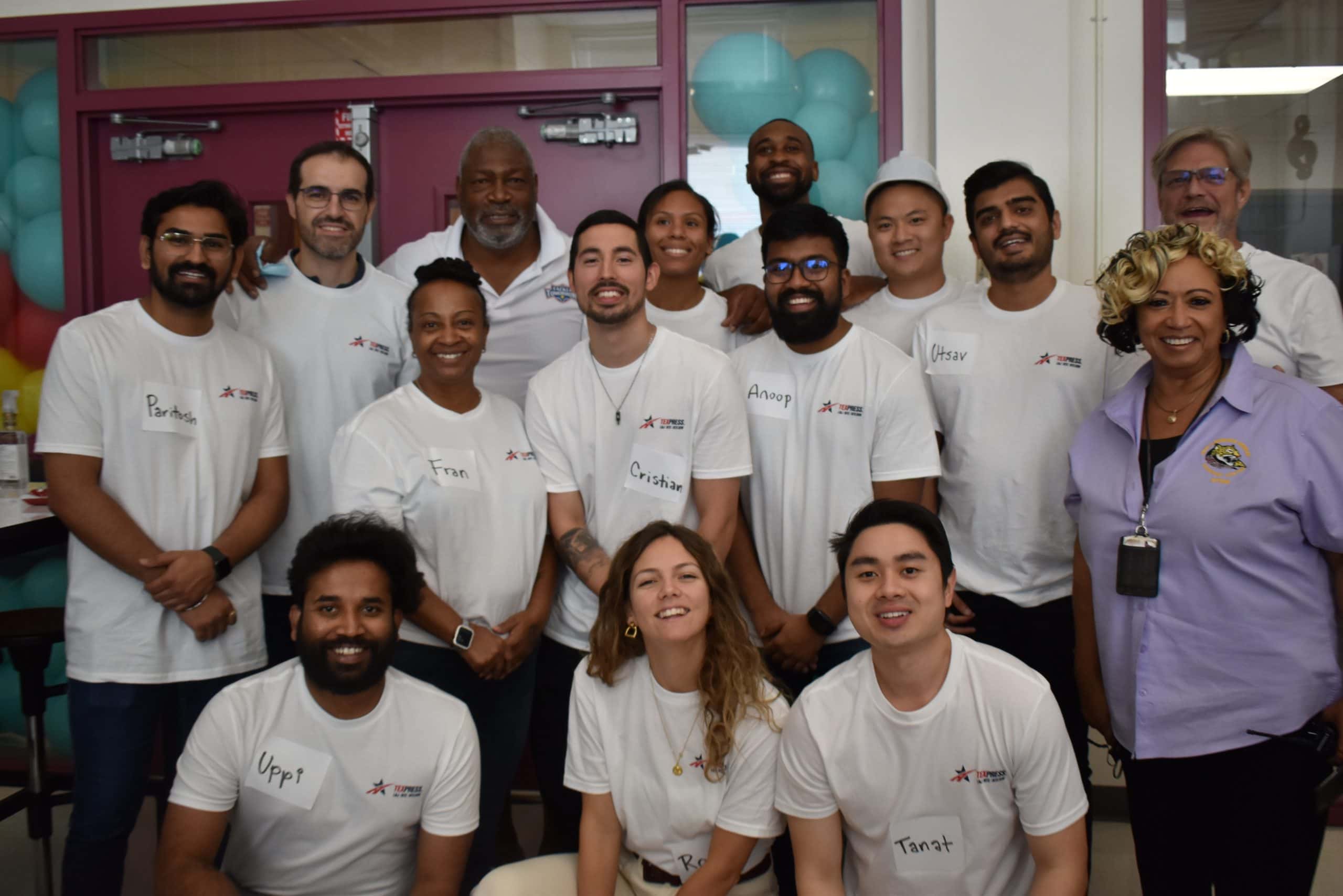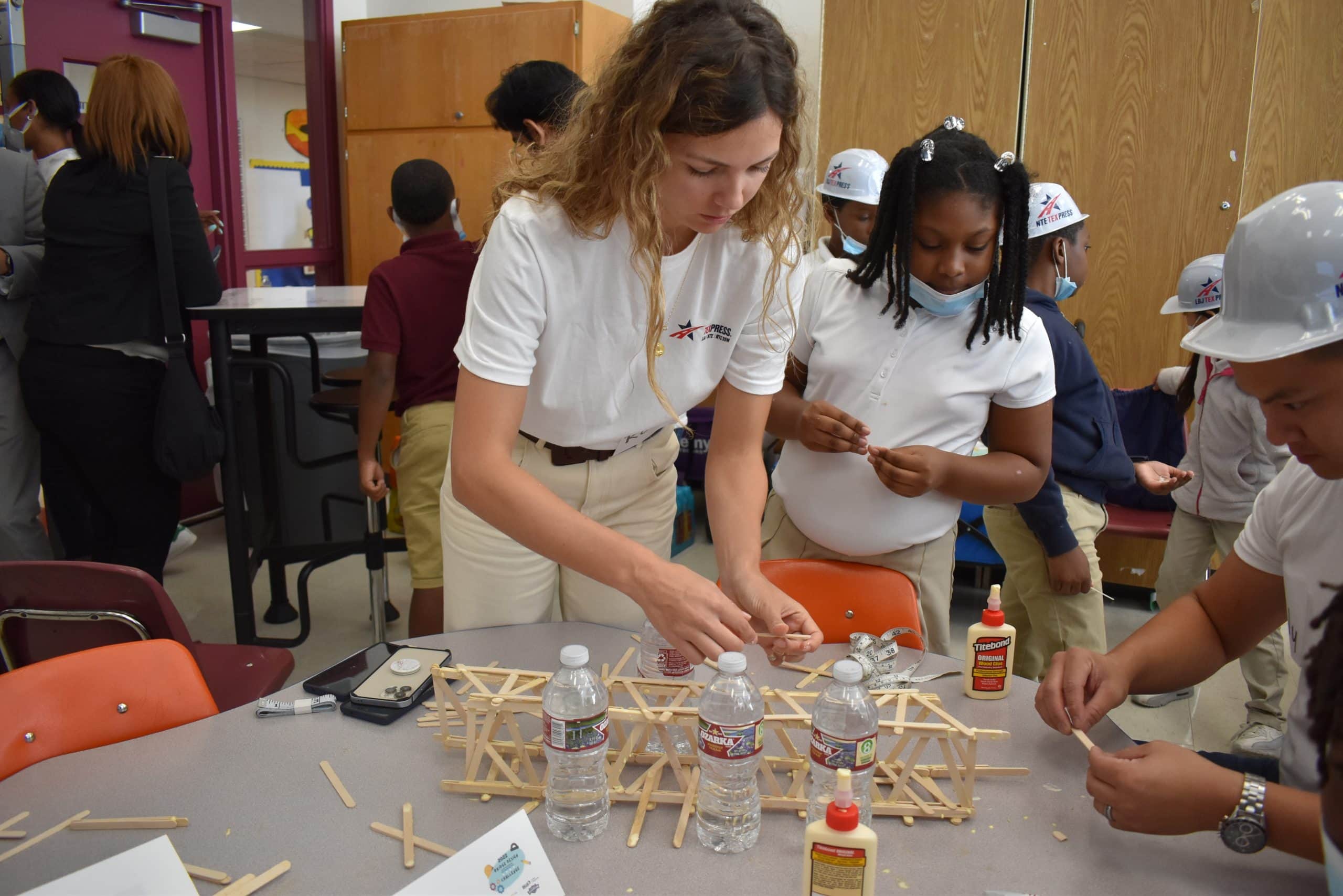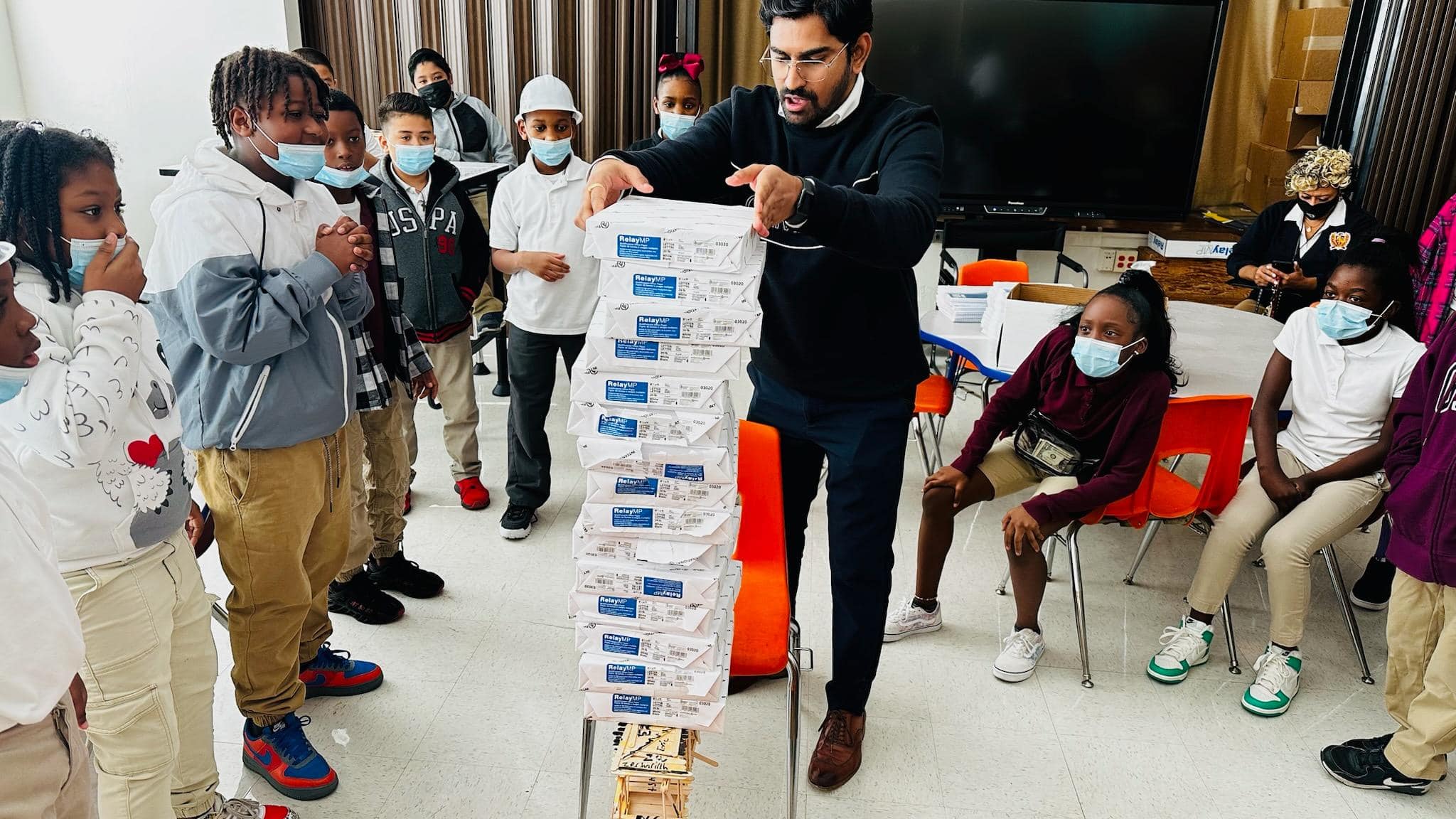
Main Photo: (Paritosh Upadhyay, Operations Engineer; Upender Telukuntla, Traffic Revenue Engineer; Ruben Roman Gonzalez, Deputy CEOP of LBJ-NTE-NTE3; Fran Prostell-Cary, Accountant; Charles Haley, Former Dallas Cowboy Hall of Famer; Cristian Canut Sierra, Engineer; Maria Del Rocio Lopez De Lucas, Operations Engineer; Bobbi Bullitt, Tackle Tomorrow Director of Community and School Affairs; Ancha Anoop, Operations and Maintenance Engineer; Tanat Vanichpipat, Traffic Revenue Engineer; Marcus Warren, Senior Corporate Affairs Specialist; Andy Nguyen, Marketing Manager; Utsav Kachhadiya, Operations Engineer; Alpher-Garrett Jones, Principal at Dunbar Learning Center; Robert Hinkle, Director of Corporate Affairs)
On Friday, September 30, 2022, industry-leading transportation professionals and engineers from the LBJ, NTE & NTE 35W TEXpress Lanes in Dallas, Texas, worked with young, aspiring STEM students at Paul Dunbar Learning Center on a bridge building competition. The engineers were on hand to provide guidance and insight to these outstanding students as they utilized their emerging skillsets to design and construct models of bridges, that would ultimately be tested for how much weight they were able to withstand.
Twenty students and eight engineers were divided into four very competitive teams. The teams of seven had only two hours to design and construct a bridge intended to hold more weight than their competitors. The teams took varying approaches to both their design, time management and the building of their bridges.
“We are very excited to be a small part of helping these students become exposed to engineering and bridge design through a unique partnership with Tackle Tomorrow Foundation and the Dallas ISD STEM Department program,” stated Ruben Ramon, Deputy Chief Executive Officer. “Today’s student could very well be the engineer who designs the bridge of tomorrow.”
The role of the Dallas ISD STEM Department is to clearly define and communicate well-rounded education as it relates to the state curriculum (TEKS and Endorsements) and provide opportunities for students and teachers to participate in department-related events collaboratively with community members. These may consist of engineering organizations, higher education institutions, technical institutions, industry partners, and informal partners. In addition, the Environmental Education Center (EEC), Mathematics, Science and Wellness departments are responsible for providing content district professional development and campus support.
After an introductory lesson on civil engineering in transportation and bridge construction, the third through fifth grade students at Dunbar engaged in an exercise to build a bridge from popsicle sticks with their final products being assessed for their efforts by a group of judges, which included engineers, teachers, District and school administration as well as TEXpress team members. One of the primary purposes of selecting the bridge building activity is to increase participation and interest in the Dallas ISD Districtwide Mathematics Bridge Building Competition during the annual STEM EXPO.
“Our department works very hard with our industry and community partners to provide Dallas ISD students with fun, engaging, hands-on, interactive activities and opportunities that spark and increase their interest in STEM disciplines and career fields. Today we are providing an opportunity for students to explore the Engineering Design Process to support the campus’s participation in the District’s annual bridge building competition,” commented Crystal Alexander, Manager of the Dallas ISD STEM Department. “Thank you to TEXpress and Tackle Tomorrow Foundation for being our partners in teaching our students.”
Dallas ISD is also home to The Largest STEM EXPO in Texas, where students explore, design, and create real-world STEM activities. The Dallas ISD STEM EXPO has over 180 hands-on exhibits and serves as the culmination event for our District Championships: Coding, Digital Tech Fest, Lego, Mathematics Bridge Building, Mathematics Dimension U, Science and Engineering Fair, VEX Robotics, and Tech Connect (*new). It also showcases the District’s collegiate academies, STEM/STEAM campuses, and the career and technical education pathway.
Each student team was paired with a professional engineer and had no more than 2 hours to design and construct a bridge which measured a minimum of 2-feet-long, made from only two materials: popsicle sticks and glue. The bridge had to be strong enough to hold at least one ream of paper. A paper ream is a package of 500 sheets of paper consisting of the same quality and style that have been cut to the same size. In this situation, each ream of paper weighed approximately 20 pounds.

Maria Del Rocio Lopez de Lucas, LBJ Express Engineer, designs and builds a truss bridge made only from popsicle sticks.
The following teams competed in the competition:
Team 1, who chose a unique and energy-charged name, “Electrocutor” consisted of: Ny’Leah Barr, Birzarith Correa, Ronald Mejra, Gabriel Montez Reid and Eric Sanchez Montero. The team was led by Utsav Kachhadiya and Upender Telukuntla.
Team 2 selected a ‘punny’ name that emphasized the trust they placed in one another as a team, “Truss Builders”: Jazmin Calderon, Karen Nunez, Ja’Tory Parkman, Drew White and Zatrarious Wright. Bridge engineers leading their team’s efforts were Anoop Ancha and Fran Prostell-Clary
Going with the theme of consistency in choosing their name, Team 3 went with “Just Keep Gluing”. Maria Del Rocio Lopez de Lucas (Rocio) and Andy Nguyen provided guidance and counsel for their young students: Dorian Crowell, Kaydance Lee, Christopher Perkins, Zechariah Wallace Wilson and Eric Williams.
And, finally, Team 4 preferred the name “Blue Tigers” and was comprised of: Madyson Carson, Isaiah Luster, Corizma Mikel, Eric Montgomery and Khloe Tatum. The Blue Tigers were anchored by engineers Tanat Vanichpipat and Cristian Cantu Sierra.
These teams worked diligently for two hours with their only break coming at the midway point of the competition when they paused their work—only briefly—to be addressed by a very special guest on hand to have an up-close and personal account of the work the teams put forth during this challenging competition.
Not only were these wonderful students supported by world-class engineers who actually design and oversee the building of actual bridges we drive on every day, they were treated to something that certainly does not occur on a daily basis—a visit from a former Dallas Cowboys legend, NFL Hall of Famer and five-time Super Bowl Champion, Charles Haley.
Mr. Haley founded the Tackle Tomorrow Foundation, which is a 501(c)(3) non-profit organization, in 2014 along with long-time Dallas civic leader Bob Bowie to improve early childhood literacy rates and provide family support services. Tackle Tomorrow Foundation has a made a profound impact on the education of students and the lives of families throughout Dallas.
“To be involved with the young students at Dunbar is so great. I know from my own experience that education is the key,” stated Tackle Tomorrow Foundation founder and five-time Super Bowl Champion Charles Haley. I want to challenge each of these students to know that they can accomplish anything they put their mind to. It’s our responsibility to help these kids unlock their dreams through education.”
Haley, an accomplished, enthusiastic and positive leader, also emphasized to the students and teachers that they should “never give up on our dreams” and stressed that we have to work hard to earn successes in life and “it all starts with education” at a young age.
After Mr. Haley addressed the students, faculty, administration and staff, the work resumed to complete design and construction of the teams’ bridges which had been partially built. At this point in the competition, all four teams were at various points of completion on their projects. One of the teams appeared to practically be finished with the project. Another team was very far along with their construction. A third team appeared to have just started constructing their bridge. The fourth and final team had not yet glued any popsicle sticks together, although this group had spent the entire first hour of the competition drawing out a design, in great detail, which outlined every aspect of the bridge they were about to construct.
With about 45 minutes remaining in the competition, there began to be a buzz in the room about whether or not all four teams would complete the assignment before time expired. There was still a team who had only assembled a few popsicle sticks together while the other teams had conjoined hundreds of sticks together in what appeared to be very sturdy miniature bridges.
When TEXpress’ own Robert Hinkle called out the ‘one half hour remaining, 30 minutes left in the competition” warning it was almost certain that only three teams would have completed the assignment in the time allotted for the competition. Two of the teams appeared to be nearly finished with their bridges with the remaining team shaping up to be completing with bridge within the time restrictions. And, once again, there was a significant amount of work left to be completed for the final team.
The stress of the competition increased significantly when the announcement was made that there was only 15 minutes remaining on the timer. At this point, many observers in the room were convinced the judges would only be evaluating three completed bridges. While three bridges appeared all but completed, the fourth and final bridge lay unassembled in four separate sections on the team’s workstation. Poised and confident, the students and engineers of this team continued, uninterrupted, working diligently on the task at hand.
And, then it began—10, 9, 8, 7, 6…would we have four bridges that could support weight? The countdown continued—5, 4, 3, 2, 1…and then, Mr. Hinkle exclaimed, “Time’s up! Everyone stop working! Time’s up!” And, to our amazement, on the four areas that had been the homebase for each of the respective teams for the past two hours stood four very different bridges in the middle of each table.
Once the clock displayed all zeros everyone could breathe a sigh of relief. With sticky hands and smiles on their faces, each of the teams began to walk around the room and observe and marvel at the wonderful work of each of the competing teams. It was at this point each of the teams really began to evaluate the work of their competitors, trying to determine which team might have the upper hand with a strong-looking bridge. Then, in grand elementary school style, it was time to celebrate the accomplishments of all four teams with a pizza party for all of the participants!
And after a long weekend of glue drying and nervous anticipation, the bridges were ready to be tested for weight capacity on Monday, October 3, 2022 at 9:30 a.m. All the bridges were judged on how much weight it was able to withstand and, according to the rules, the bridge that would be capable of supporting the most weight would win the competition.
All four of the teams’ bridges were put in place to begin the most important portion of the competition—to determine which of these bridges could withstand the most weight. The tension in the room built as the first reams of paper were suspended from each of these bridges. As each team had hoped, all four bridges easily withstood a single ream of paper.
With nervous apprehension, the judges prepared the second round of weight to each of the bridges and the suspense continued to grow. And, once again, success for each of the teams—all four bridges held the weight of two reams to paper. Sweating palms and perspiring brows were ever-present in the classroom as the third paper reams were added to the total weight.
Amazingly, all four bridges able to withstand a whopping 15 pounds of weight. That’s right, popsicle sticks and glue alone were capable of holding a payload of nearly ten times its own weight. Now, the anticipation is overwhelming as the fourth round of weight—20 pounds—is placed on the bridges and all bridges pass the test with flying colors. Then, the fifth round commences and things change quickly. The bridge constructed by the Blue Tigers was eliminated after it collapsed under 25 pounds of weight.
With the final three teams more nervous than ever after the first bridge failed, the judges continued to add weight to the remaining bridges. Round after round of adding weight took place until each of the three bridges were able to support 50 pounds! In the eleventh round, the streak was broken when the bridge built by the Truss Builders could withstand no additional weight.
And then there were two! The final duo of teams knew one would be crowned the winner. The anticipation was at an all-time high. The judges then began to add more and more weight. Round after round was completed and both bridges held up to the increased pressure. When would it end? Which bridge would survive?
After a grueling session of adding round followed by round of weight to determine which team would be the winner, the Paul Dunbar Learning Center principal, Ms. Alpher Garrett-Jones, ultimately stepped in to declare the competition a tie between to teams. Astonishingly, the final two teams were able to hold an impressive 75 pounds of weight.
Ms. Garrett-Jones noted, “This is not about breaking the bridges, it is about celebrating the accomplishments of these wonderful students. We wanted to have a bridge—or in this case, two bridges—to display in our glass cases so students, parents and visitors who come into Dunbar every day can see what our students are capable of doing. This is amazing and we are excited!”
Ultimately, the judging officials went to the ‘rule book’ to determine that in the event of a tie with weight, the secondary qualifier is cost efficiency (or number of popsicle sticks used in constructing the bridge). This is the same rule which applies for all students in the Dallas ISD STEM E|XPO competition. And, when the dust from the broken popsicle sticks settled, the winning team was “Electrocutor”.
Congratulations to all the students, faculty, administration, engineers and volunteers who made this exciting STEM exercise possible!

Paritosh Upadhyay, LBJ/NTE Operations Engineer tests which bridge can hold the most weight.